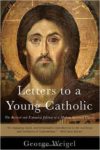It took me nearly two months to get through this book. Not because I was bored, but quite the opposite—there’s a lot to digest, and I wanted to make sure I didn’t miss anything. The chapters are like “letters,” as if Weigel is really writing to the reader (i.e., me). In a way, that makes you pay attention to it more. When he takes you on a virtual journey through a basilica, you mentally turn left when he points to something in that direction. When you go down a set of stairs, you feel the mustiness of a crypt. It’s almost personalized, and it works.

“Young” Catholic doesn’t necessarily mean in age, though that’s the typical audience. It’s also beneficial to those new to the faith (again, me) or returning. This book was actually gifted to me by a non-Catholic for my Confirmation. I imagine they just went into a bookstore and picked up the most Catholic-looking book they could find. I don’t think they knew how relevant it was. Each letter contains an explanation of something in the faith that may be new to the newbies, from the definition of an icon to the story behind Our Lady of Guadalupe. But even the most basic of information is presented in an informative, factual way that’s not degrading. You don’t feel silly for not knowing. You’re young, after all.
Each letter begins with a place—a cathedral, a town, or a seemingly ordinary countryside—and explains its religious significance. It then delves into a related matter of faith. It goes from the Sistine Chapel to a bar in England to Auschwitz. It discusses heavenly Good and the worst evils. It’s not just factual, but also a challenge to live the faith.
A couple letters get very political, which I rarely understand, so those parts went over my head. I got what he was doing by the end of it, but missed a lot of the explanation in the middle. But the faith-based letters, and the especially the ones in locations I’d visited before, loudly resound. I quite liked visiting the Church of the Holy Sepulchre and St. Peter’s Basilica again, even if only in memory.
